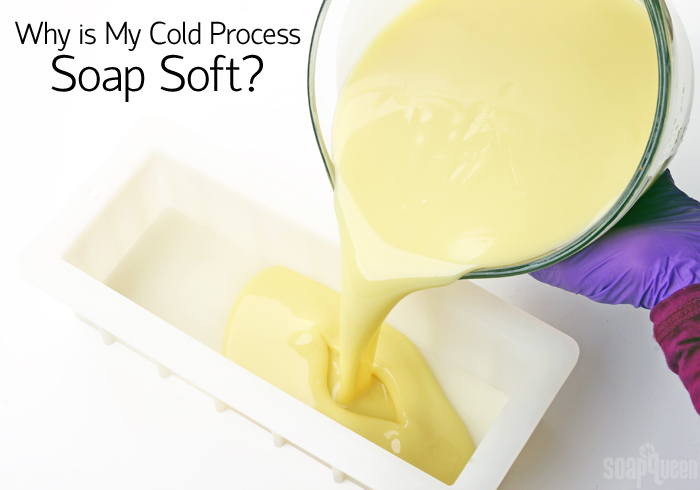
Cold process soap requires patience. It needs several days to harden in the mold. Then, it needs to cure for 4-6 weeks to allow excess water to evaporate. Curing creates a firmer bar that lasts longer in the shower. All this waiting can be the hardest part of cold process soapmaking! But, what if your soap takes longer than usual to harden? If your soap is still soft to the touch after a week or two, something might be a little off.
Soap can take anywhere from 1-15 days to harden in the mold, depending on a variety of factors. Two to three days in the mold is average. There are several factors that determine how long soap needs to harden. The first is the type of oils in your recipe. The more soft oils (such as olive, sweet almond, rice bran, canola, etc.) the soap contains, the softer the bars will be. It may take more time to harden in the mold. The more hard oils the recipe contains (such as palm, coconut, cocoa butter, beeswax, etc.), the quicker the soap will harden. For example, if the soap is made with 100% olive oil, it may take up to two weeks to unmold. But if the soap is 60% hard oils, it could be ready to unmold the next day.
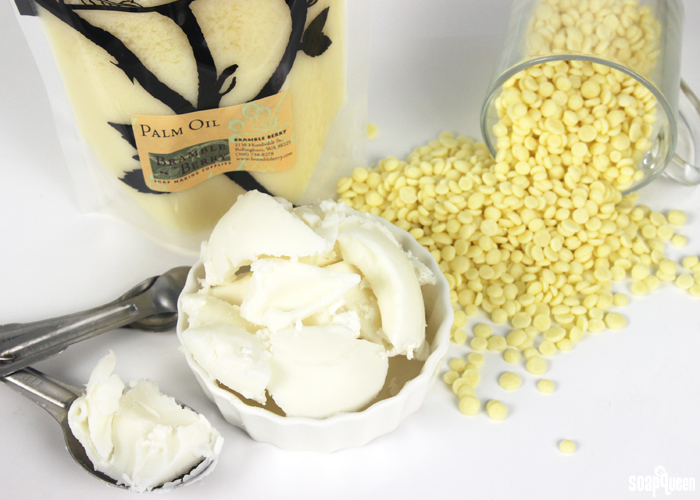 Using more firm oils and butters in your recipe will result in a firmer bar of soap.
Using more firm oils and butters in your recipe will result in a firmer bar of soap.
Another factor is the superfat of the recipe. Oil that’s not turned into soap by the sodium hydroxide lye is called the “superfat.” An average superfat is anywhere from about 1-7%. The higher the superfat, the more “free-floating” oils in the soap. The terms “superfat” and “lye discount” can be used interchangeably. This is because in order to create a superfat, you use less lye in the recipe. Extra oil creates a more gentle bar, but it can also make the bar softer. If you used a large superfat (generally 7% or more) and the bar feels soft to the touch after a few weeks, the superfat may be the culprit. Personally, I use a superfat of 5% in most of my cold process recipes. I have found this to be a good balance between a firm bar that’s also gentle on the skin.
Speaking of “extra stuff” in your soap, let’s talk additives. Colorants and fragrance oils are the most common “additives” and they can make soap soft if too much is added. Dispersing powdered colorants in lightweight liquid oil is a great way to avoid chunks and streaks of color in the final bar. But, if you add too much dispersed colorant it can soften the bar because you’re adding more oil as well. In fact, you’re technically increasing the superfat! If you calculate your recipe to have a 7% superfat and add lots of dispersed color for example, you may end up with a soft bar. Usually, colorants are dispersed at a rate of 1 teaspoon colorant to 1 tablespoon lightweight liquid oil. If you want to add a lot of colorant, you may want to decrease the amount of oil in your dispersion.
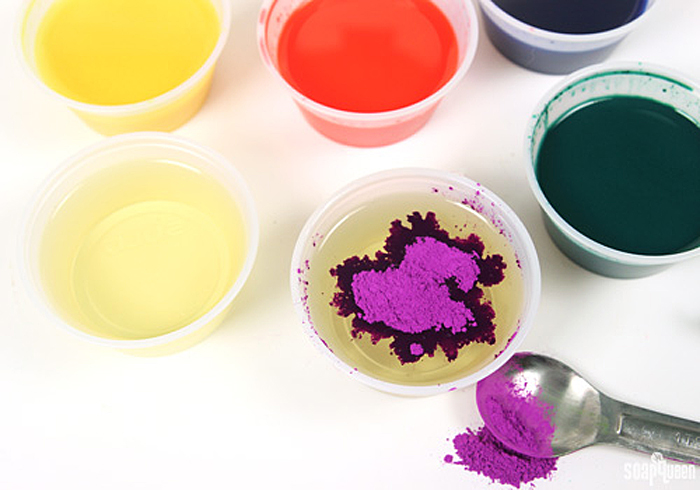 Adding too much extra oil (like with dispersed colorants) can lead to a soft bar of soap.
Adding too much extra oil (like with dispersed colorants) can lead to a soft bar of soap.
Adding too much fragrance oil can also lead to a soft bar of soap. That’s where the Fragrance Calculator comes in! Simply enter which fragrance oil you’re using, what you’re making and how much. The calculator will give the amount of fragrance oil that’s safe for skin. The amount given by the calculator won’t lead to a soft bar of soap. That’s one of the reasons why it’s so important to measure your fragrance oil by weight; it gives you the most accurate amount of fragrance oil for your project. Adding more fragrance than recommended could lead to a soft bar.
Soap might be soft if too much liquid is used. The Bramble Berry Lye Calculator creates recipes with 22% distilled water in the total recipe. Other lye calculators might have a slightly lower or higher percentage. That’s because the amount of water in your recipe can fluctuate, and still be totally fine. Using less water in your recipe is known as water discounting.
Water discounting has several benefits including decreasing the chance of glycerin rivers and creating a bar that unmolds faster. Learn more about water discounting soap here. On the other hand, if you use more water than suggested, it takes longer for the soap to become firm. This also applies to adding other liquid additives like milk or purees to your recipe. Too much extra liquid (milk, purees, etc.) on top of the water in the lye solution causes soap to not harden correctly.
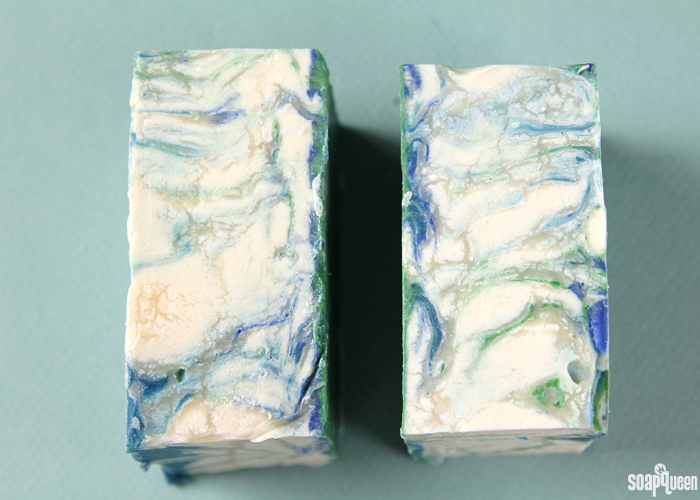 Water discounting soap reduces the chances of glycerin rivers, shown above. It also produces a bar that hardens faster.
Water discounting soap reduces the chances of glycerin rivers, shown above. It also produces a bar that hardens faster.
The type of mold also affects how quickly soap hardens. In general, cold process soap made in silicone and plastic molds takes longer to harden and umold. This is because silicone and plastic molds create an airtight seal that doesn’t allow for any air to touch the soap. The more airflow, the faster soap hardens. Soap made in wood molds lined with freezer paper has a little more airflow, which helps the soap release faster. In addition, wood molds tend to promote gel phase. If soap goes through gel phase, it becomes harder faster.
If using a silicone or plastic mold for cold process soap, use sodium lactate. Actually, I recommend using sodium lactate for all your batches! It’s a liquid salt that can be added to cooled lye water at a rate of 1 teaspoon per pound of oils in cold process soap. It’s optional, but I use it in 99.9% of my recipes. It facilitates the hardening of soap, making umolding faster and a longer lasting bar in the shower. For example in the photo below, the soap on the left contains sodium lactate while the bar on the right does not. The bar without sodium lactate was softer, and did not unmold as cleanly. Click here to learn more about sodium lactate.
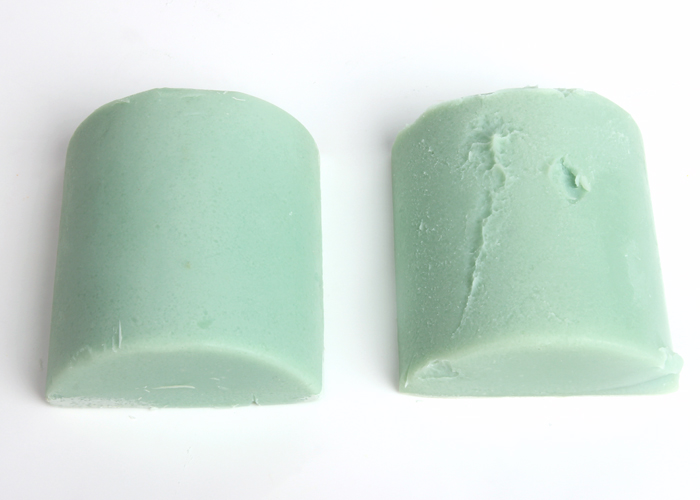 The bar on the left contained sodium lactate, while the bar on the right did not.
The bar on the left contained sodium lactate, while the bar on the right did not.
So, what can you do about a soft bar of soap? The good thing about soft soap is that it’s very rarely lye heavy! Lye heavy soap usually has the opposite problem; it’s extremely hard, brittle and crumbly. If your soap is too soft, chances are you added too much of something…but not lye. It’s usually too much oil, fragrance, liquid or other additive. The bad news about soap that’s too soft? It’s a little tricky to fix. The only real option is to rebatch the soap. To help firm it up, you can add shreds of a firm bar. This helps balance it out. Learn more about rebatching soap here.
What can you do if you want to ensure your soap unmolds within about 2-3 days? Check out my tips below.
- Use at least 40% hard oils in your recipe. These include coconut oil, palm oil, cocoa butter, etc. This post has a list of common soaping oils, with general recommended usage rates to aid in formulating your recipes.
- Stearic acid at 0.5% of your oils can be used as a hardening agent in cold process soap. It does speed up trace, so keep that in mind!
- Sodium lactate is your friend! Because I like to unmold my soap within about 2 days, I use sodium lactate all my batches. It’s a liquid salt that’s added to cooled lye water. It helps the soap harden more quickly, which helps it release cleanly from the mold. If I use sodium lactate, I can sometimes unmold my soap the next day.
- Water discount your soap anywhere from 5-20%. Just keep in mind the more you water discount your recipe, the faster your soap will accelerate. Generally, I don’t water discount more than 15% unless I’m in a huge hurry to unmold. If you’re adding ingredients like purees, I recommend water discounting to take the extra water in the puree into consideration. Check out this post for more info.
- Decrease the superfat. The more extra oil you have in your soap, the softer it will be. I have found 5% to be a good balance between firmness, and a skin-loving bar.
- Promote gel phase. When soap goes through gel phase, it speeds up the saponification process. This results in a bar that is firmer more quickly.
- Thicken the trace of your soap. Soap that is poured into the mold at a thin trace will need more time in the mold than thick traced soap.
- Using an accelerating fragrance oil helps your soap harden in the mold faster.
How long do you usually wait to unmold your soap? In general I always recommend 2-3 days, but sometimes you can get away with unmolding the next day if you use some of the tips above!




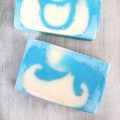
I made a cp soap with 30% superfat
30%oo co and lard
10% coffee infused oo
Hasn’t hardened
How do I rebatch?
How to Make Rebatch Soap: https://www.soapqueen.com/bath-and-body-tutorials/cold-process-soap/soap-queen-tv-presents-how-to-make-rebatch-soap-2/
Though depending on how soft the soap you may have hard time shredding it up. Rebatching also will not make it harder unless you add in rebatch for a another, harder cold process recipe.
30% is a very high superfat so that could be part of why the soap is so soft along with the higher olive oil content. We normally superfat at about 5%.
Hello, new too cold process soap. First successful batch is in mold now as of yesterday, question on the recipe I use… coconut oil, shea butter, caster oil and olive oil as my 4 oils and argon essential oil… what would be a good percentage of each for a hard but moisturizing bar? thanks for replies!
Our typical recommendation is at least 30% butters in your recipe for a hard bar. So with this recipe you would want to use at least 30% total of Coconut Oil and Shea Butter.
I am new to soapmaking and just made my first batch of olive oil soap and have it curing right now. However, I made a second batch of olive oil soup and the soap in one of my molds hardened evenly just like my first attempt. However, another soap I had set in another mold next to it is hardened on the edges and squishy in the center. I honestly don’t know what went wrong.
*soap not soup. Darn typos
It can depend on a lot of different factors. The mold you use is one of them as some might breathe more than others. It can also be the fragrance or the temperature you are working at as well. If the recipe is different it could be the recipe as well.
Mam, I have been doing cp soaps for commercial purpose. But my customer do says that soap gives eyes irritation . I do check my ph for every batch. I use coconut oil, sesame oil, ricebran oil, castor oil, karanja oil.
Is sesame oil hard or soft carrier oil?
Please do reply. How to avoid eyes irritation.
Lavanya ,india
Even if your soap is completely safe and gentle even it can definitely cause eye irritation and it should be avoided in that direct area.
Sesame Oil is a soft carrier oil.
Hi
I live in a hot country now and my palm and coconut oil are liquid at room temperature. Do you think my cold process soap will still benefit of their hardening properties? Because I dont understand why all of my soap are not hard even after the cure. People complain it dissolve quickly in the shower. And when i press the soap with my finger ( after 4-6 weeks cure) i can see its not hard enough.
Thank you very much for your help
You will usually fully melt your hard oils and butters before adding them to cold process soap. Having them liquid beforehand will not affect the hardness of your soap or the quality.
Usually the what oils you choose to use and their ratio will be the main thing to affect the hardness of your soap. Sodium Lactate will also help with hardness.
How to Make Soap Last Longer in the Shower: https://www.soapqueen.com/bath-and-body-tutorials/tips-and-tricks/make-soap-last-longer-shower/
Hi, thanks for the good work you’re doing, this is quite an informative post. I’m not sure if this has been mentioned in the comments, I just felt I should add: using individual cavity moulds, depending on the recipe, can allow unmoulding in a much shorter time, especially if the resulting soap bars are only about an inch or two thick. I use a silicone baking mould that gives me 1 inch thick soap bars, and have been able to unmould some soap recipes in 2 to 3 hours. Of course it helps that they can be pushed out from the bottom . Castille still takes a while as expected, but can be coaxed out of the mould in 3, 4 days tops. I think the trick is to saponify small(er) pieces of soap as opposed to one large loaf.
. Castille still takes a while as expected, but can be coaxed out of the mould in 3, 4 days tops. I think the trick is to saponify small(er) pieces of soap as opposed to one large loaf.
Naturally, like all things this way of doing things may not be the best / most desirable for everyone. For instance, I think it would be easier to achieve gel in a large mass of soap due to the saponification heat being maintained in a larger body of soap. But anyone who makes small quantities of soap like I do (and doesn’t necessarily want the soap to gel), or commercial soap-makers who don’t mind having multiple cavity moulds, pouring the soap into smaller moulds allows it to harden way, way faster than the same soap would if poured into a large loaf mould.
Ok, back to reading through the blog. Wish you all the best. Love from Nairobi.
I have waited for more than 24hours but my soap is still soft how many days do I need to wait
That depends on your recipe. For most recipes I wait 48 hours to unmold most of my soap recipe to make sure they are nice and hard. Some recipes can take up to a week or longer to harden up, like castile recipes. Using Sodium Lactate can help your recipes harden up faster.
Sodium Lactate: https://www.brambleberry.com/Sodium-Lactate-P5127.aspx
Hi..I can’t unmolded my soap even after a week. it’s still too soft. and this is my recipe:
30% coconut oil
30% palm oil
3% castor oil
7% avocado oil
5% sunflower oil
25% olive oil
I didn’t use sodium lactate, and using silicone mold.
Thank you.
That sounds like a great recipe. Though without the Sodium Lactate and using a silicone mold the soap will take longer harden. To help speed this along you can put your soap in the freezer for about 24 hours. This will make the soap easier to unmold. Then wait another 24-48 hours with the soap unmolded to cut your bars.
I’m not sure where I went wrong, but I tried making my husband a puck of shaving soap this past Saturday and it is still pretty soft on Tuesday. Everything suggests it shouldn’t be though. It’s 60% kokum butter, I used a 1.5:1 water to lye ratio, I added a pinch of salt to speed up hardening, I poured it at thick trace, and I insulated it to try keeping the temp up to keep saponification going at a good speed. It reached thick trace very quickly when I was blending it. I may have soaped it a little too cool at around 100°F. I used tea as the liquid. Could that make it soft? Should I even be worried at this point?
Did you use a silicone mold? Since you didn’t use Sodium Lactate it can take 3-5 days to unmold from silicone since it doesn’t allow for the soap to breathe on the bottoms. You should be able to remove it in a few more days!
It’s in a ramekin actually and won’t be unmoulded. Probably can’t breathe in that either. I was still able to leave finger indents in the top when I checked it yesterday.
It sounds like it is just because it is in a ramekin that it is still so soft. It should definitely still be safe to use and should slowly continue to harden up throughout the cure.
I am not sure if this is the right section, but on some other posts that were more related, I was not able to post a comment. Anyway, some of my soaps (CP) where opaque with no gel phase after curing period. But after using some soaps for some days, they started becoming translucent and softer in the translucent area. But it didn’t happen to all the soaps of the batch. Is there an explanation for this?
Thank you for your time!
How did you store your soap, and how long did it cure? The center may have gelled a bit, causing that partial gel.
thank you so much for this very helpful information..please keep up the great work.
You’re welcome, thanks for reading.
Can i still use soft soap for myself, or does it means it won’t perform properly or do something bad to my skin?
As long as the soap is pH 9-10 it’s just fine to use on the skin. If the soap is really soft, you may find it doesn’t last as long in the shower. It helps to keep it in a dry area on a draining soap dish.
Learn how to test pH here: https://www.soapqueen.com/bath-and-body-tutorials/tips-and-tricks/troubleshooting-lye-heavy-soap/
Hi.. Is there a way to test the soap before curing process? Since the curing process is long is there a way to check if the soap will be good after it gets cured.
Thanks
After about 5 days the soap is safe to use on the skin so you can give it a try. However, soap performs best when it cures, so we recommend waiting the full 4-6 weeks. If you don’t like the consistency, you can rebatch it with more soap to make a more balanced bar: http://www.soapqueen.com/bath-and-body-tutorials/cold-process-soap/soap-queen-tv-presents-how-to-make-rebatch-soap-2/
Hi,
I made some handmade soap using someone’s recipe, but used a different butter than called for. I think that’s why my soap is very soft and sticky. I want to try to turn it into liquid soap and use in the shower. My question is, do I still have to let it cure 4-6 before trying to turn into liquid? Thanks, Cindy
What was in the recipe, and how long has it been curing? You can’t turn solid soap into liquid soap, but you can rebatch it to make a more balanced bar. That involves heating the soap and forming into new bars: http://www.soapqueen.com/bath-and-body-tutorials/cold-process-soap/soap-queen-tv-presents-how-to-make-rebatch-soap-2/
hi, I already done a rebatching recently. the previous batch was using 100% pure olive oil. and way too soft and didn’t seem to hardened (already wait for 2 weeks in room temperature).
how much percentage of hard oils (coconut oils) to use in rebatching?
Soap made with 100% olive oil needs at least 6 weeks to cure, we recommend up to 2 months. After then it will get harder and will have more lather. Learn more about 100% olive oil soap here: https://www.soapqueen.com/bath-and-body-tutorials/castile-cold-process-soap-tutorial/
If after then you still want to rebatch it, you can mix it with a hard soap made with hard oils like coconut and palm. This Basic Rebatch Base is a good option: https://www.brambleberry.com/Grated-Rebatch-Soap-Base-Basic-P4540.aspx
Learn more about rebatching here: http://www.soapqueen.com/bath-and-body-tutorials/cold-process-soap/soap-queen-tv-presents-how-to-make-rebatch-soap-2/
awesome!! thank you for replying. will gives you update after 6 weeks
thank for your help. am contented
You’re welcome, thanks for reading.
Hello, thank you for providing information about Why is My Cold Process Soap Soft?
I love to read the article there are many important points throughout the article Thanks again for your information
You’re welcome, thanks for reading.
Hello, I’m new to CP and excited to make my own recipe! But I am not sure on what type of bar that it will produce. I have read and tried to follow the suggested % on each oil or butters and 60% liquid to 40% hard rate. My recipe is:
10% Avocado oil
13% Canola oil
5% Castor oil
5% Cocoa butter
15% Coconut oil
15% Hempseed oil
12% Olive oil (pure)
20% Palm oil
5% Sweet almond oil
With a super fat of 7%
Would this recipe be ok? Do you have any suggestions if it’s not? Would it have a lot of lather or not much? Will it be soft or hard? On bramble berry.com the usage rate for natural hemp seed oil is 15% but on soap queen .com it says 20%, so I am a little confused on the suggested rate I should follow. Thank you for your time and any and all help would be greatly appreciated!
That recipe looks good! It should be balanced and have some nice lather. If you’re just starting out, it may be easier to just use a few oils. A mixture of 25% coconut oil, 25% palm oil, 3% castor oil, and 47% olive oil is a great base recipe. It’s firm yet moisturizing, and the castor and coconut oil add great bubbles.
-Kelsey with Bramble Berry
I cannot find how much lye to add to the batch of soap. I have missed that measurement somewhere. Can you give me the amount in the coconut milk recipe.
Absolutely, the Lime in the Coconut Milk Cold Process Recipe calls for 5.2 oz. of sodium hydroxide lye: https://www.soapqueen.com/bath-and-body-tutorials/cold-process-soap/lime-in-the-coconut-milk-cold-process-tutorial/
-Kelsey with Bramble Berry
I made 3 recipes before but after using I had the same problem in all of them ,which is the bar of soap start to be soft and sticky after 2 or 3 days using where is the mistake?
I used mixed of coconut oil,olive oil and palm oil with the lye only .
How long did you let that soap cure? There are a few tricks to making your bars last longer in the shower.
-Kelsey with Bramble Berry
Actually I left it for 6 weeks before using it , but in 2 recipes I used around 10% sun flower oil.could it be the problem?
If the bar has more soft oils it can be softer. What else is in your recipe?
-Kelsey with Bramble Berry
in one of them i used 400g olive oil ,100g sun flower oil,50g coconut oil with lye.
on another one I used 200g olive oil, 68g palm oil, and 93 sun flower oil with lye NaOH .
Because the bars have a high amount of soft oil, they will be on the softer side. You can add more hard oil, like up to 33% each of coconut and palm. It also helps to add 1 tsp. of sodium lactate per pound of oils to your cooled lye water.
This post talks about formulating recipes: http://www.soapqueen.com/bath-and-body-tutorials/tips-and-tricks/formulating-cold-process-recipes/
Learn more about sodium lactate here: http://www.soapqueen.com/bramble-berry-news/sunday-night-spotlight-sodium-lactate/
Another way to make those bars more firm is with a water discount: http://www.soapqueen.com/bath-and-body-tutorials/tips-and-tricks/water-discounting-cold-process-soap-how-why/
-Kelsey with Bramble Berry
I made a mistake with my recipe and accidentally finished a soap with a 25% superfat. I was able to unmold it and cut it, but I don’t think it’s ever going to harden. I’m planning to rebatch. Are there any concerns or risks about adding the remaining lye (dissolved in a bit of water) and mixing it really really well in the rebatch? Do you think it’ll bond with the free oils?
You won’t want to add any extra lye to your soap. The recipe has already finished turning into soap, so the lye won’t – instead, it will remain active and it can irritate or burn the skin. Instead, I would recommend rebatching the soap with equal or double the amount of a hard soap. That will make the bar more balanced.
Learn more about rebatching soap here: http://www.soapqueen.com/bath-and-body-tutorials/cold-process-soap/soap-queen-tv-presents-how-to-make-rebatch-soap-2/
The Basic Rebatch is a nice firm recipe: https://www.brambleberry.com/Grated-Rebatch-Soap-Base-Basic-P4540.aspx
-Kelsey with Bramble Berry
Another thing that can cause a soft bar is old lye. Anne Marie recommends lye less than a year old, and that’s great advice. I have found old lye loses its strength and doesn’t saponify the oils fully, so the bars don’t harden properly. It’s kind of like superfatting, only you don’t have any control over it. So fresh lye is a must!
Absolutely, that’s a great tip Kathy! Fresh lye really helps.
Read more about expired lye here: https://www.soapqueen.com/bath-and-body-tutorials/tips-and-tricks/expired-lye/
-Kelsey with Bramble Berry
When I made my pumpkin spice soap, I forgot to discount the extra liquid from the pureed pumpkin. Result: soft soap that took weeks to harden. It was supposed to be ready for Halloween, but ended up being a Christmas soap. And that was despite using sodium lactate.
The extra liquid from that pumpkin will definitely soften the soap! The good news is it will make amazing Christmas gifts.
-Kelsey with Bramble Berry
can you use carnuba wax or candilila wax in soaping or are they too hard to use?
We haven’t worked with candelilla wax a lot, so I’m not entirely sure! I would recommend making a small test batch with 8% or less candelilla wax. You’ll want to soap hot – at least 160-180F – to keep the wax melted the whole time. That way you can see how the wax works.
-Kelsey with Bramble Berry
Great info! The only fragrance oil I have ever had this problem with is lavender. I’ve made a number of batches with differing oils and butters and I always use a water discount and my soap is always very soft for a long time. I rarely am able to get it clean out of the mold without leaving the corners behind or making dents in it, I leave it for up to 5 days and have tried putting it in the freezer. Also when mixing my colorants, I just use a tablespoon of my soap batch oils, so I never am adding any extra oil.
Hmm, that’s weird! We use lavender often and haven’t experienced that with our batches, so I’m not quite sure why that’s happening. Maybe a recipe with more hard oils or sodium lactate would help when using lavender.
-Kelsey with Bramble Berry
Yes its weird. I always use sodium lactate, and I’ve made this with a 3 butter recipe too. I usually have a fairly firm trace by the time I pour, and I always gel. I’ve used Lavender and Cedar, and Lavender Bouquet and no problems with those.
AND I tend to have a lot of soda ash where I have hardly any with other fragrances. My plan is to just use individual molds rather than a loaf mold next time I use lavender and see how that works.
Individual molds will definitely harden faster! I think that sounds like a good idea.
-Kelsey with Bramble Berry
To help control the soda ash do a light spray of the higher percent rubbing alcohol on the top of your soap right after pouring into your mold. We usually never have a problem.
I tried making a salt solution using the ratios of salt to water listed under how to thicken liquid soap. If you use .5 oz. salt and 1.5 oz. distilled water; then the salt will not dissolve. I do not know what the correct ratio is; but it is not 3:1. I tried using sea salt, iodized table salt and even fine salt for the neti pot. The salt would not dissolve in the water even when heated and stirred. Further research indicated you need either more distilled water or less salt. I will update this comment after I learn the correct ratio of salt to water.
Hi Patricia!
I prefer to use Cocamidopropyl Betaine to thicken LS instead of salt water. So far, the only kind of LS I have found it won’t work on is one is one made with Coconut Oil. Not sure why since Cocamidopropyl Betaine is derived from Coconut Oil, but it thickens all the other LS soaps I tried it in. LS can be thickened by adding 3% (by weight) of Cocamidopropyl betaine. Hope this helps!
The .5 oz. of salt in 1.5 oz. of water won’t fully dissolve, and that’s OK! When you add it to the soap, the additional water will dissolve that leftover salt. We added quite a bit to the dilution so the soap won’t get watered down.
-Kelsey with Bramble Berry